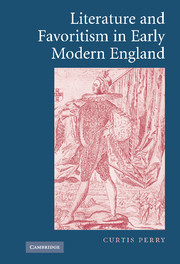Book contents
- Frontmatter
- Contents
- Acknowledgments
- A note on texts
- 1 “Prerogative pleasures”: favoritism and monarchy in early modern England
- 2 Leicester and his ghosts
- 3 Amici principis: imagining the good favorite
- 4 Poisoning favor
- 5 Erotic favoritism as a language of corruption in early modern drama
- 6 “What pleased the prince”: Edward II and the imbalanced constitution
- 7 Instrumental favoritism and the uses of Roman history
- Afterword: “In a true sense there is no Monarchy”
- Notes
- Index
6 - “What pleased the prince”: Edward II and the imbalanced constitution
Published online by Cambridge University Press: 22 September 2009
- Frontmatter
- Contents
- Acknowledgments
- A note on texts
- 1 “Prerogative pleasures”: favoritism and monarchy in early modern England
- 2 Leicester and his ghosts
- 3 Amici principis: imagining the good favorite
- 4 Poisoning favor
- 5 Erotic favoritism as a language of corruption in early modern drama
- 6 “What pleased the prince”: Edward II and the imbalanced constitution
- 7 Instrumental favoritism and the uses of Roman history
- Afterword: “In a true sense there is no Monarchy”
- Notes
- Index
Summary
The plays discussed in chapter 5 use the trope of erotic incontinence to figure favoritism as the representative symptom of tyranny, a perspective that re-imagines the favorite as the vehicle by which the king's unruly will asserts itself. This is why so many of the early modern English fictions dealing with corrupt favoritism as erotic desire are set in what to the English were the symbolic locations of absolutist excess: France, Muscovy, imperial Rome, Catholic Italian dukedoms, the Muslim east. Such stories can of course be intensely topical for English audiences interested in favoritism or absolutism, but they deal with imagined states that are understood to be crucially unlike England, with its native liberties and balanced constitution. The central native exemplum of passionate and corrupting favoritism, for late Elizabethan and early Stuart writers, is clearly the tale of the reign, deposition, and murder of King Edward II.
The story is utterly ubiquitous in the period's controversial political writing, where it serves as a highly contested precedent for arguments about the nature and limitations of English monarchy, and it is perhaps the most frequently retold political fable of the era as well. The best-known version is of course Christopher Marlowe's (c. 1591–92) but we also have significant recastings of the story by Michael Drayton (who produced several long poems about Edward's reign in different modes), Richard Niccols (who added a narrative of the life of Edward II to the Mirror For Magistrates collection in 1610), Francis Hubert (whose long verse history of Edward's life and death underwent a number of significant revisions between its original composition in the 1590s and its eventual printing in 1628 and 1629), and Elizabeth Cary (who composed a Tacitean history of the Edward II story as a way to comment upon political controversy c. 1627).
- Type
- Chapter
- Information
- Literature and Favoritism in Early Modern England , pp. 185 - 228Publisher: Cambridge University PressPrint publication year: 2006



